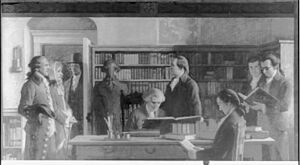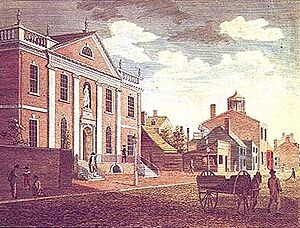Library Company of Philadelphia facts for kids
Quick facts for kids Library Company of Philadelphia |
|
|---|---|
 |
|
| Established | 1731 |
| Location | 1314 Locust Street, Philadelphia, Pennsylvania, U.S. |
| Collection | |
| Size | 500,000 books; 70,000 other items |
| Access and use | |
| Circulation | Non-circulating collection |
| Population served | Free and open to the public |
| Members | Benjamin Franklin originally |
| Other information | |
| Director | Interim |
| Staff | 25 |
| Website | http://www.librarycompany.org/ |
The Library Company of Philadelphia (LCP) is a special library in Philadelphia, Pennsylvania. It was started in 1731 by Benjamin Franklin. This library has collected many important historical books and papers over the years. It holds one of the most valuable collections in the United States.
Today, the library has about 500,000 books and 70,000 other items. This includes 2,150 items that once belonged to Benjamin Franklin himself. There are also large collections of old pamphlets, maps, and entire libraries from the 1700s and 1800s. You can even find first editions of famous books like Moby-Dick and Leaves of Grass here.
Contents
History of the Library Company
How the Library Started


The Library Company grew out of a discussion group called the Junto. This group was led by Benjamin Franklin in colonial Philadelphia. On July 1, 1731, Franklin and his friends decided to create a library. They often needed facts for their talks but couldn't find enough books.
In colonial Pennsylvania, books were hard to find and expensive. Most people, including Franklin and his friends, didn't have much money. They couldn't afford to buy many books on their own. So, they decided to pool their money. This way, everyone could share a large collection of books. The first books were mostly about religion and education. It was special because most books in other libraries at that time were in Latin, but these were in English.
Early Librarians and Rules
The first librarian hired in America was Louis Timothee. He worked for a short time before Franklin took over. Franklin was the librarian until 1734. After him, William Parsons served for 12 years. Robert Greenway was the fourth librarian, staying until 1763.
The library had rules for its members. New members had to be approved and pay a fee. They also paid a yearly amount to help buy new books.
Even people who were not members could borrow books. They had to leave money equal to the book's cost. This money was returned when they brought the book back. Members could borrow books for free. The library was only open on Saturdays for four hours in the afternoon.
Growth and Important Collections
Over time, 50 people became members. Each paid 40 shillings and promised to pay ten shillings a year. This helped buy books and keep the library running. This is why it's called "the Mother of all American subscription libraries." A list of desired books was sent to London. Soon, the first books arrived.
Early libraries in the American colonies belonged to wealthy people, church leaders, or colleges. The Library Company was different. Members started donating their own books. These included works by John Locke and Plutarch.
The library's collection grew quickly. By 1741, it had 375 titles. About a third were history books, travel guides, and geography. A fifth were literature, mostly poetry and plays. Another fifth were science books. Only a small part was about religion. This made the Library Company different from college libraries like Harvard and Yale.
A Place for Science and History
The Library Company also collected interesting objects. These included old coins, fossils, and natural history items. In 1739, the library received an air-pump. This led to the creation of a special cabinet to hold it.
The library moved to the second floor of the State House in the 1740s. Benjamin Franklin and his friends did their first electricity experiments there. The library's microscope and telescope were often borrowed. In 1769, Owen Biddle used the telescope to watch the transit of Venus.
The library grew and moved to the Carpenters' Company hall in 1773. When the First Continental Congress met there in 1774, the Library Company let all the delegates use its books. This offer was repeated for the Second Continental Congress and the Constitutional Convention. Many signers of the Declaration of Independence were members. The Library Company served almost like the Library of Congress until 1800.
In 1785, the Company bought a collection of important papers from the American Revolution. These included posters and pamphlets that no longer exist anywhere else.
New Home and Loganian Library
In 1789, the Library Company bought land for its own building. It was designed by Dr. William Thornton. The building was red brick with white columns. A statue of Franklin stood in a niche above the door. The new library opened on New Year's Day, 1791.
In 1792, the Loganian Library joined the Library Company. This added 2,600 books, mostly in Latin and Greek. It also included a great medical library. This meant the new building needed an extra wing right away.
19th Century Changes
The library's collections continued to grow in the 1800s. By the mid-1800s, it was seen as one of the "five great libraries" in the United States. The others were at Harvard, Yale, the Library of Congress, and the Boston Athenæum.
The Library Company's collections were split into two locations in the mid-1800s. A new building called the Ridgway Library was built. Later, another library designed by Frank Furness opened in 1880.
It's important to know that the Free Library of Philadelphia was started in 1891. It was meant to be "free to all" and opened in 1894. This is a separate library from the Library Company of Philadelphia.
20th Century Revival
During the Great Depression, the Library Company faced money problems. It had to sell one building and put all its collections in the Ridgway Library. After World War II, things got better. The library focused on being a place for scholars to do research.
In the second half of the 1900s, under Edwin Wolf II, the library became very important again. It opened a new building on Locust Street in 1965, also called the Ridgway Library. It welcomed the public in April 1966.
See also
- Free Library of Philadelphia
- History of public library advocacy
- Life in Philadelphia
- Public library advocacy

